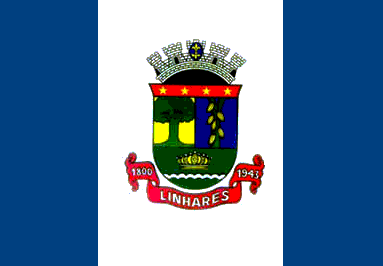 image by André Pires Godinho
image by André Pires GodinhoSource: Municipal Chamber

Last modified: 2013-07-20 by ian macdonald
Keywords: espirito santo | linhares | triband: vertical (blue | white | blue) | coat of arms |
Links: FOTW homepage |
search |
disclaimer and copyright |
write us |
mirrors
 image by André Pires Godinho
image by André Pires Godinho
Source: Municipal Chamber
The municipality of Linhares (141,254 inhabitants in 2010; 3,501 sq. km,
therefore the most sprawling municipality in Espírito Santo) is located in
northern coastal Espírito Santo.
Linhares was founded in 1809 on the site
of an earlier colonial settlement destroyed by the Botocudos tribe. Located
on river Doce, the settlement was protected by two military barracks aimed at
warning the colonists in case of attack. The today's borough named Aviso
("Watch") recall this time. The settlement was named for Rodrigo de Souza
Coutinho (1755-1812), first Count of Linhares, Prime Minister of Portugal for
two months in 1801 and the first Minister of War of Brazil (1808-1812).
Linhares was made a "vila" and the seat of a municipality of the same name in
April 1833. The first official session of the Municipal Council took place on
22 August 1833, which is considered as the date of foundation of the
municipality. Its territory then encompassed the today's territories of
Linhares, Rio Bananal, Colatina, Baixo Guandu, Pancas, Sáo Gabriel da Palha
and Sooretama, as well as parts of Ibiraçu, Santa Tereza and Itaguaçu. At
the end of the 19th century, Linhares was outgrown by Colatina, which
profited of the Italian immigration, of the coffee boom and of the marshaling
yard on the railway line Vitória - Minas. The municipality of Colatina,
incorporating the town and the old municipality of Linhares, was created on
30 December 1921, which increased the decline of Linhares. In 1930,
Linhares reemerged with the building of roads to Vitória and Sáo Mateus. The
municipality was reestablished on 31 December 1943.
The flag of Linhares
is 1.70 m on 1.20 m. It is made of a white rectangle of 80 cm in width,
flanked by two blue rectangles of 45 cm in size. The municipal coat of arms
is placed in the middle of the flag. No historical record of the flag was
found, therefore the meaning of its colors is unknown.
The coat of
arms of Linhares is "A Portuguese (Iberic) shield, per pale, 1. Or a tree
vert (green), 2. Blue (azure), a cocoa tree trunk fructed or, a chief
dimidiated gules (red) four stars or per fess, a terrace vert (green) a fess
wavy argent ensigned by a Count's coronet or with its nine characteristic
pearls argent. On a scroll gules (red) the writing "1800 - Linhares - 1943".
The shield surmounted with a five-towered mural crown argent, for a town, the
central tower with an ellipse azure charged with three fleurs-de-lis or."
The Portuguese shield represents the Portuguese origin of Brazil. The tree
symbolizes the region, rich in timber wood. The fructed trunk represents
cocoa [the cocoa pods indeed appear mostly on the tree trunk]. The four stars
represent the "bandeirantes" (pioneers) Dias Arzão, Antonio Dias Adorno,
Marcos Azevedo Coutinho and Martins Cão. The Count's coronet recalls the
Count of Linhares. The fess wavy stands for river Doce. The fleur-de-lis
represents Our Lady of the Conception, the patron saint of the municipality.
http://www.linhares.es.gov.br/Cidade/Simbolos.htm
[Note that the
image shown on the municipal website has wrong proportions.]
Ivan Sache, 21 January 2012